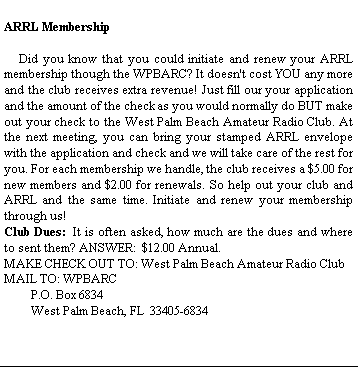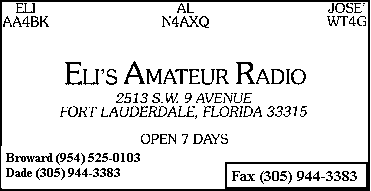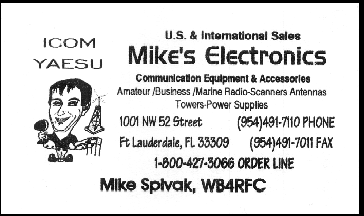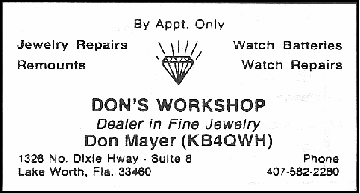FROM YOUR PRESIDENT
The September issue of QST has some articles that I found to be very interesting and timely. I would like to share parts of them with you.
First, in the New Ham Companion The Doctor is In (page 52) the question was asked "Who wrote the Amateur's Code?". It was written by Paul M. Segal in 1928 and is as relevant now as it was then. The Code states that the Radio Amateur is:
Considerate... knowingly operates in such a way as to lessen the pleasure of others
LOYAL... offers loyalty, encouragement, and support to other amateurs, local clubs, and the American Radio Relay League, through which Amateur Radio in the United States in nationally and internationally.
PROGRESSIVE... with knowledge abreast of science, a well-built and efficient station and operation above reproach
FRIENDLY... slow and patient operation when requested: friendly advise and counsel to the Beginner; kindly assistance, cooperation and consideration for the interests of others. These are the hallmarks of the amateur spirit.
BALANCED... radio is an avocation, never interfering with duties owed to family, job, school, or community.
PATRIOTIC... station and skill always ready for service to country and community.
In light of the problems we are having currently and those in the past, Club members and the rest of the Hams in the county need to look at themselves and make the changes necessary to achieve the ideals expressed in the Code.
The second article appears in Correspondence, page 24. It is titled "Teens speak". This article is very controversial as it relates to the requirement of passing a CW test to get a license. I found it especially interesting since the author is 16 years old. In part this is what Chris Johnson, AE4KN, had to say:
"We live in a dumbed-down, instant gratification world. I've seen it in my school with standardized tests. Instead of working to improve teaching techniques, our country reacted to plummeting test scores by lowering the standards. How does this relate to Amateur Radio? Instead of making it easier to pass the tests, how about making it more enjoyable to learn the material in the first place, INCLUDING the code?
...speaking of the code, the whining has become tiresome. We're talking about 5 WPM here, about a character every two seconds! It's just not THAT hard. Kids who learn the code agree, and they'll tell you that it's the adults doing most of the anti-code gripping..."
I would love to hear your comments on these or any other subject at the meeting. P.S. if I don't hear any comments, especially on the code article, I'll know you're not reading what I write!
At the meeting we will be discussing the Budget that appeared in the August Propagator and get it approved. Speaking of the Budget, what would you think of giving a break on the dues for each new member a person recruited? Say half a years dues at the new rate for each new member recruited.
We have a volunteer for the Editor of the Propagator - Sam Falco. I also will be looking for people to form a nominating committee. Also, we need volunteers to man tables at the Hamfest in October and ideas/volunteers to finish renovation our trailer. The trailer needs to be done by the end of the year if we want to use it for Lake Park's 75th Anniversary.
Has anyone been checking WWV to see what the sunspots are doing? I did just a little while ago and they were up to 96! If you haven't been operating HF because the bands are dead you would be surprised at how they have improved with just this little increase in sunspots. By winter the HF bands will be great!
See you at the meeting!
Bill AA0BA
 |


|
I WANT THE BEST ANTENNA
How many times have you heard this either on the repeater, or the ragchew, or at the Picadilly?
The best reply, even thought it sounds like a put down is which is better; a knife, a fork, or a spoon. What would you say?
"What's for dinner, I guess all three"
To do a good job with whatever shows up on our plate, everyone would like more tools. It's the same with antennas. Every antenna made is the best for some purpose or situation.
Wire antennas are easy to work with, durable, versatile, and unobtrusive, but each design has particular advantages. The same can be said for HT whips , range extenders, and beams. It may seem that there are too many different types. But reading about them will help you think through your goals and define the limitations you have to work with.
And there's always the element of discovery. The laws of physics won't be overruled. But often what seems like a limitation, can be turned to an advantage. Sometimes too, one antenna works better in a particular situation than another for reasons we can't explain with the knowledge we have of the site and setting. That's part of the adventure too.
The best antennas for your situation are still to be discovered. Talk to others who have your situation. Talk to the various "old timers". There are lots of answers.
from Radio Adventure, Provo, Utah.
How loop Antennas Work
Loop antennas are versatile low noise antennas that don't require long spans. Often they can fit in restricted spaces, lie on the roof, or hid in a garage. There are different multi-band loops or single band loops. Each has specific advantages.
Any loop will radiate effectively on a vast number of frequencies. It doesn't even have to be resonant in and of itself to be an effective multifrequency radiator. The main trick is to obtain a good impedance match to the transmitter for the frequencies desired. As a consequence, the main difference between the various types of loops described here is the method of matching provided. A single band has a simple and efficient match for its design band. The method used permits certain unique advantages on that band. The other antennas use systems that maintain efficiency at many frequencies. Details of matching methods are given with each loop described. The most important aspect of a loop antenna is its radiation pattern. Though a loop of a given size can radiate effectively on many different frequencies, the direction of strongest radiation varies with frequency. At the frequency where the loop is a full wave in circumference, strongest radiation is out from the center of the loop and broadside to to the plane of the loop. At frequencies where the loop is shorter or longer than a wavelength, radiation moves away from the center of the loop toward the edges, leaving a deepening broadside null, while progressively moving the strongest radiation fields toward the plane of the loop. When a loop becomes very small (less than 1/3 of a wavelength) or very large (greater than 8 times the wavelength) maximum radiation is effectively in the plane of the loop.
The one wavelength delta loop with the broadside radiation is the special case. The broadside radiation is generally 3db or more stronger than the radiation in the plane of the loop. When the loop is horizontal, ground reflections enhance the upward radiation on the fundamental frequency.
Ground reflections lend a decreasing upward tilt but a 160-meter horizontal loop no higher than 25 feet above the ground still delivers progressively lower angle DX on the higher bands.
The shape of a horizontal loop may cause some directions to be favored over others, but there is effective radiation in all compass directions so long as the loop is roughly equilateral or circular and not tightly pinched.
In the case of an 80 meter loop hung in the vertical plane, the same progression of radiation intensity takes place, beginning broadside on 80. On 40, a shallow null appears broadside while diagonal directions are favored. Each higher band see the favored direction draw closer to the plane of the loop. For a vertical loop there is no progressive lowering of the radiation angle however. Instead there is a significant radiation at nearly all vertical angles. Again the shape of the loop, height above ground, and feedpoint location influences the favored take-off angle.
from Radio Adventure, Provo, Utah


Tapping out a SOS: Keep Morse Code in emergency drawer.
Recently, all the electricity in my house went out.
When we tried to turn our two flashlights, we discovered that the batteries were dead. We finally went to the emergency drawer in the kitchen and pulled out some candels and matches. By the candles' light, dinner was finished, dishes were cleaned, and put away, homework was completed and stories were told. By that same candlelight I read a magazine articles about the gradual phasing our of the supposedly anitquated system of Morse Code. I thought, with a great sense of irony, that those who wished to do away with Morse Code probably didn't have any candles in an emergency drawer somewhere.
The U.S. Coast Guard ababdoned Morse in 1995. At midnight, this past Jan. 31, France ended its use for Maritime communications. And the system faces global maritime extinction by February 1999.
Still, debate continues on the seas and over the airwaves about Morse. Many say it's an outdated vehicle for communication and has no place in today's high-tech world. There are, they add, faster, more powerful and more advanced means for communications, particulary in the maritime and ham radio world.
On the seas, vessels from nations that have signed the Safety of Life at Sea Treaty carry state-of-the-art equipment that allows shipboard communications officers to send emergency calls automatically. The Global Maritime Distress and Safety System uses a satellite-relayed signal that gives search teams a ship's precise location at any time. Moreover, the Federal Communications Commission now endorses, for the first time in history, a technician-class ham radio license that does not requrie a Morse Code test.
Is Morse signing off?? No! Although many believe it is out of date, Morse is still very necessary, just like a candle in the age of electricity. The code was invented by Samuel F.B. Morse in the 19th Centrury. On May 24, 1844, Morse sent a message using a wire, a battery, and two telegraph machines, one in Baltimore and one in Washington. His message, "What hath God wrought?" ushered in the modern era of communication.
In our era despite what the "experts" say, Morse is still a viable means of communication. It is still widely used, although not so frequently as before. In the maritime industry, where English is the international language, Morse is a simple and concise way to communicate ship-to-ship or ship-to-shore. All seagoing vessils are still required by maritime law to keep a Morse Code book that spells out simple letter groups that have serious meanings.
We are all familiar with the meaning of "SOS". However, there are many others. For example, "AC" means "abandoning my vessel", and any three-letter grouping beginning with "M" signifies the medical conditions of injured or sick passengers. Shore stations worldwide, using signal lamps, still flash Morse signals to approaching foreign ships to learn their intentions. Navy and merchant vessels, also using lamps, still use Morse signals in convoy while running under radio silence.
Morse Code facilitates our ability to communicate with one another. It is another option that is more efficient and reliable in an emergency when the ability to communicate with words -whether face to face or across a distance -fails us. Morse is a great candle that we should continue to keep in out emergency drawer, just in case.
Stephen A Arata, an Army Lieutenant colonel, teaches military science at Hofstra University. He wrote this article for Newsday.
